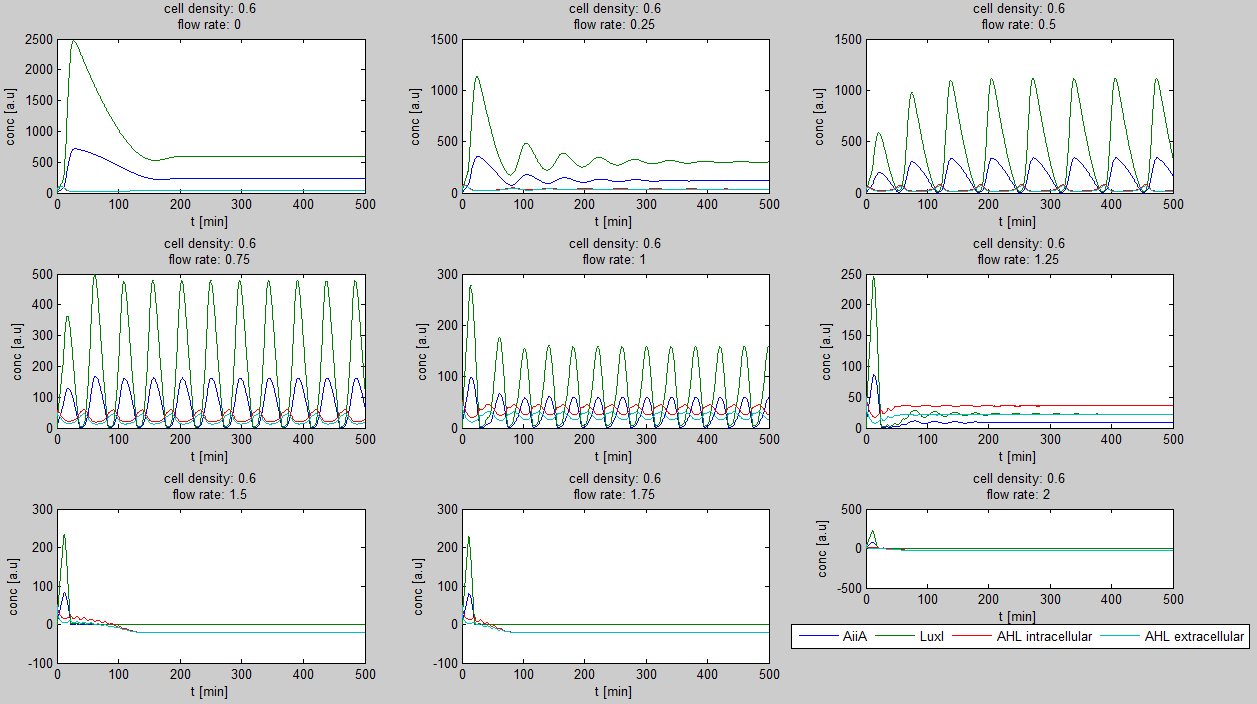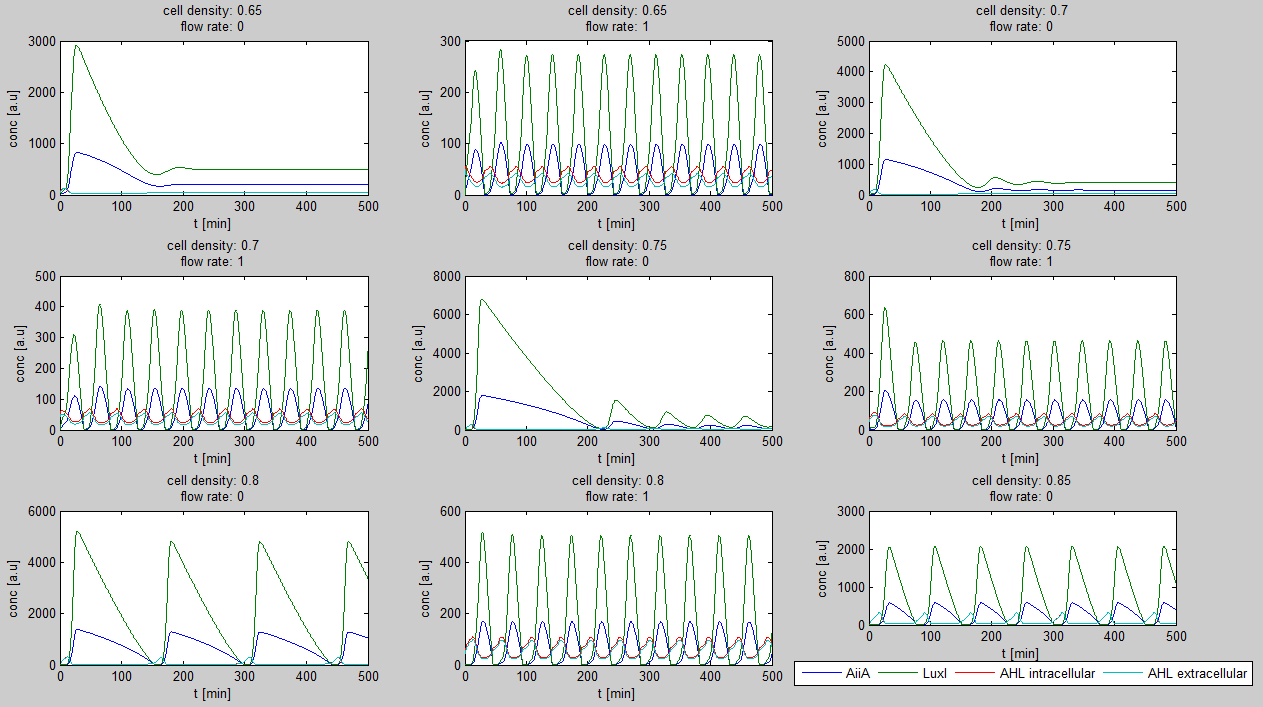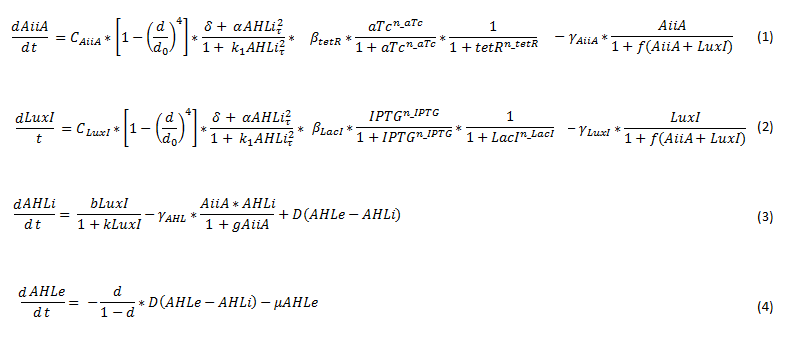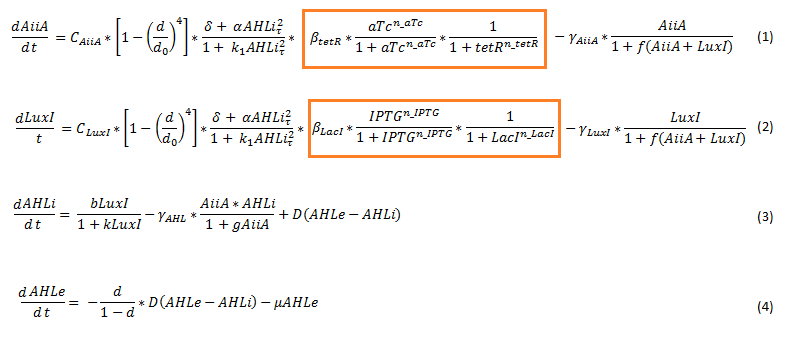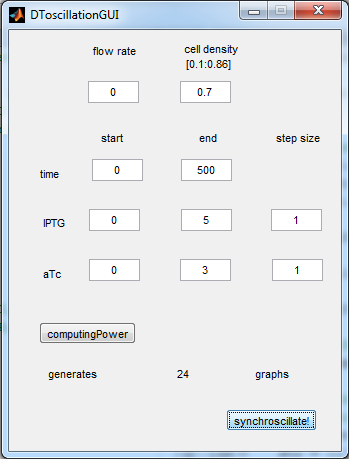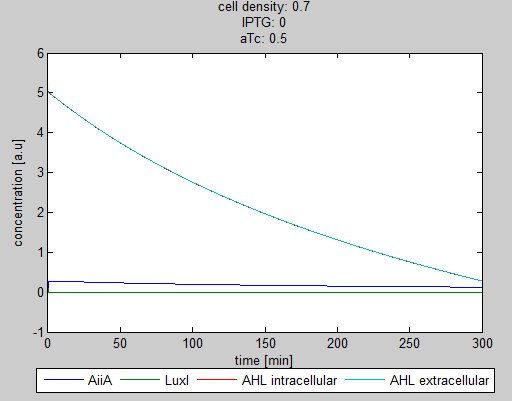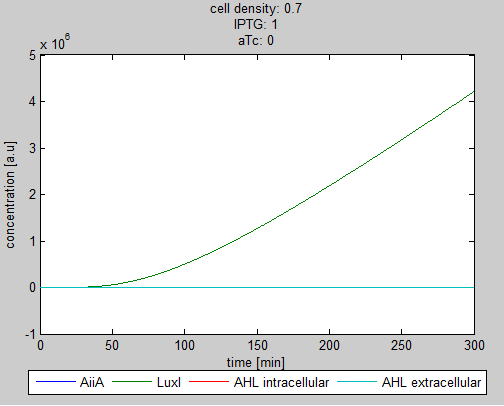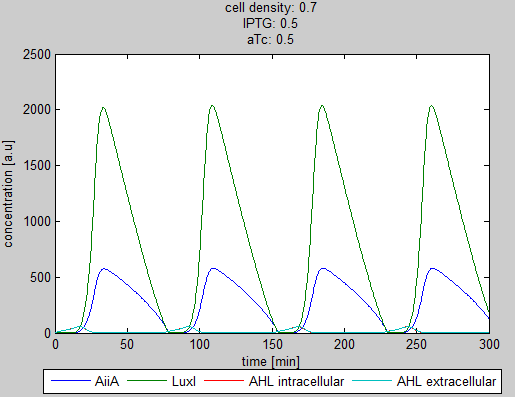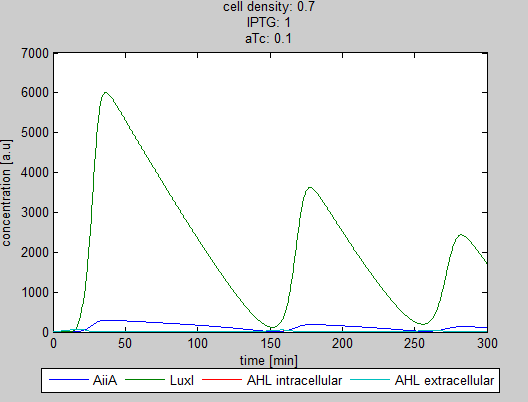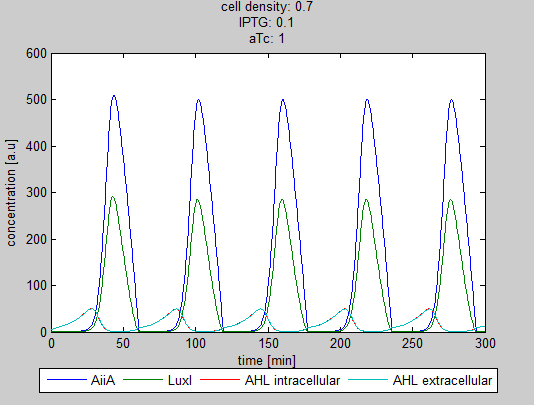Team:Wageningen UR/Project/ModelingProj1
From 2011.igem.org
RubenvanHeck (Talk | contribs) m (→Modeling synchronized oscillations) |
(→Modeling synchronized oscillations) |
||
| (4 intermediate revisions not shown) | |||
| Line 28: | Line 28: | ||
{{:Team:Wageningen_UR/Templates/Style | text= __NOTOC__ | {{:Team:Wageningen_UR/Templates/Style | text= __NOTOC__ | ||
=== Mathematical model === | === Mathematical model === | ||
| - | Since our BioBricked oscillatory system is based on the circuit published by Danino et al. in the paper “A synchronized quorum of genetic clocks” [1], our first model of the system is a reproduction of the mathematical model in the supplementary information [2] accompanying the mentioned publication. In their simulations, Danino et al. used a set of four delay differential equations, which we also used as starting point for our modeling work. | + | Since our BioBricked oscillatory system is based on the circuit published by Danino et al. in the paper “A synchronized quorum of genetic clocks” [1], our first model of the system is a reproduction of the mathematical model in the supplementary information [2] accompanying the mentioned publication. In their simulations, Danino et al. used a set of four delay differential equations, which we also used as starting point for our modeling work. |
The steps (transcription, translation, maturation etc.) from the luxI and aiiA genes to the corresponding proteins are not modeled separately. Instead, the delay of the correlation between the internal AHL concentration, which triggers the expression of the genes, and the corresponding AiiA and LuxI concentrations is simulated by a Hill function. This Hill function takes the history of the system into account, i.e. the concentration of AHL at the time it binds to LuxR to form the activation complex. | The steps (transcription, translation, maturation etc.) from the luxI and aiiA genes to the corresponding proteins are not modeled separately. Instead, the delay of the correlation between the internal AHL concentration, which triggers the expression of the genes, and the corresponding AiiA and LuxI concentrations is simulated by a Hill function. This Hill function takes the history of the system into account, i.e. the concentration of AHL at the time it binds to LuxR to form the activation complex. | ||
| + | The experimental setup of the cited paper involved the use of microfluidic devices, in which the cell density could be kept constant. Excess cells were flushed away with a predefined flow rate. This also controlled the external AHL concentration. More information can be found in the description about the [[Team:Wageningen_UR/Project/DevicesSetup| setup]] of the device. | ||
| Line 43: | Line 44: | ||
[[File:Example_output_graphs_WUR.png|770px|center]] | [[File:Example_output_graphs_WUR.png|770px|center]] | ||
| - | '''Fig. | + | '''Fig.1:''' ''Variation of output graphs depending on the different starting conditions'' |
| Line 57: | Line 58: | ||
[[File:Model0flow_WUR.png|770px|center]] | [[File:Model0flow_WUR.png|770px|center]] | ||
| - | '''Fig. | + | '''Fig.2:''' ''Graphs showing oscillatory behavior increasing with cell density even when the flow rate is set to 0'' |
Disregarding the strictly mathematical model, some more conclusions were drawn from modeling work as to whether to use a microdish or microsieve as platform for measuring oscillations. This is described in more detail in the [[Team:Wageningen_UR/Project/DevicesSetup| section about the setup of the device.]] | Disregarding the strictly mathematical model, some more conclusions were drawn from modeling work as to whether to use a microdish or microsieve as platform for measuring oscillations. This is described in more detail in the [[Team:Wageningen_UR/Project/DevicesSetup| section about the setup of the device.]] | ||
| Line 66: | Line 67: | ||
=== Expansion of the model for the double tunable oscillatory construct === | === Expansion of the model for the double tunable oscillatory construct === | ||
| - | To model the [[Team:Wageningen_UR/Project/CompleteProject1Description# | + | To model the [[Team:Wageningen_UR/Project/CompleteProject1Description#3._Designs| double tunable oscillator]], the original set of delay differential equations [2] was expanded. This involved adding the effect of the repressor and activator in the form of a Hill function to the differential equations for LuxI and AiiA. The equations for the internal and external AHL concentrations were not changed. The new set of equations is depicted below. |
[[File:Equations_enhanced_WUR.png]] | [[File:Equations_enhanced_WUR.png]] | ||
| - | '''Fig. | + | '''Fig.3''' ''Adjusted set of differential equations for the double tunable oscillator'' |
Since the LacI repressed hybrid promoter used for this system was designed by the Tokyo iGEM 2007 team [3], the additional terms were derived according to their model. The tetR repressor was then modeled using the same template. The set of equations seen above therefore integrates the features of both models. It does not include differential equations for LuxR, LacI (represses luxI) and tetR (represses aiiA). For the model we assume that these proteins are constitutively produced. | Since the LacI repressed hybrid promoter used for this system was designed by the Tokyo iGEM 2007 team [3], the additional terms were derived according to their model. The tetR repressor was then modeled using the same template. The set of equations seen above therefore integrates the features of both models. It does not include differential equations for LuxR, LacI (represses luxI) and tetR (represses aiiA). For the model we assume that these proteins are constitutively produced. | ||
| Line 110: | Line 111: | ||
| - | '''Situation 3:''' ''Equal amounts of IPTG and aTc produce oscillations as | + | '''Situation 3:''' ''Equal amounts of IPTG and aTc produce oscillations as seen in previous simulations.'' |
| Line 117: | Line 118: | ||
'''Situation 4 and 5:''' ''Interesting behavior of the system when adding IPTG and aTc in reversed proportions.'' | '''Situation 4 and 5:''' ''Interesting behavior of the system when adding IPTG and aTc in reversed proportions.'' | ||
| + | |||
| + | From the model it can be concluded that the oscillatory behavior can indeed be fine tuned. However, wet-lab experiments are needed to quantify the parameters. | ||
| Line 130: | Line 133: | ||
[2][http://www.nature.com/nature/journal/v463/n7279/suppinfo/nature08753.html Supplementary information] | [2][http://www.nature.com/nature/journal/v463/n7279/suppinfo/nature08753.html Supplementary information] | ||
| - | [3][ | + | [3][https://2007.igem.org/Tokyo/Works Tokyo iGEM 2007] |
}} | }} | ||
Latest revision as of 03:31, 22 September 2011
 "
"



